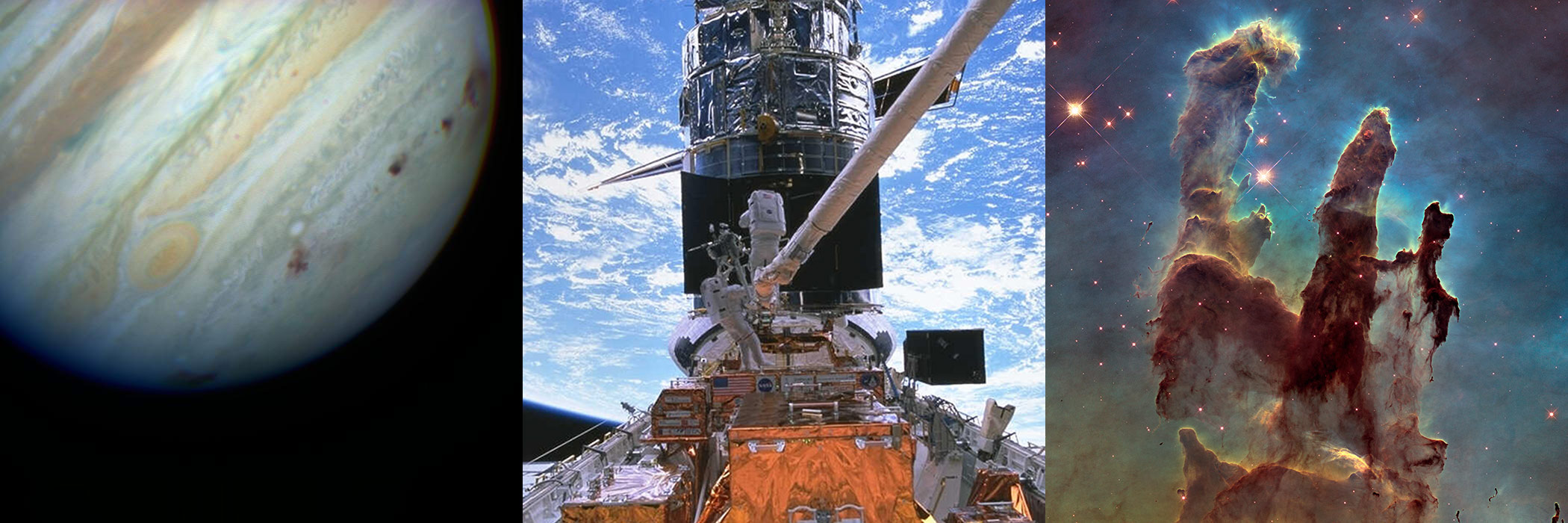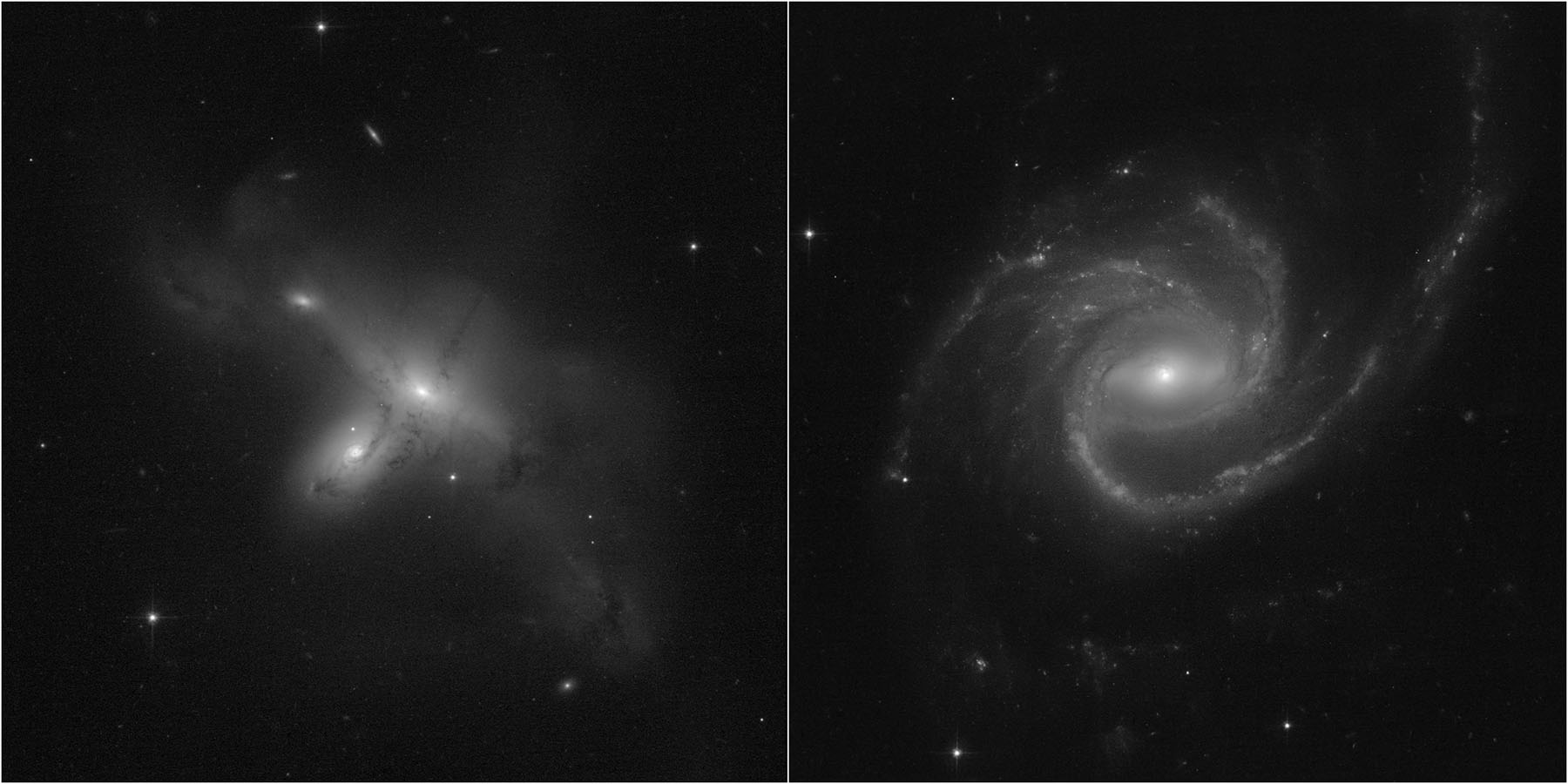Healing Hubble

Left to right: multiple impacts from comet P/Shoemaker-Levy 9 on Jupiter, credits: Hubble Space Telescope Comet Team and NASA; astronauts Smith and Lee install STIS during Hubble Space Telescope servicing mission 2, credits: NASA and ESA; one of Hubble’s most famous images, the Pillars of Creation, in the Eagle Nebula, credits:NASA, ESA, and the Hubble Heritage Team (STScI/AURA)

HUBBLE UPDATE – Monday 19 July 2021:
Hubble has returned to full science operations!
And in case you were about to say “Pix or it didn’t happen!” … here are the pix!

CREDITS: SCIENCE: NASA, ESA, STScI, Julianne Dalcanton (UW) IMAGE PROCESSING: Alyssa Pagan (STScI)
These two weird galaxies are part of a program led by Dr. Julianne Dalcanton of the University of Washington in Seattle, to survey oddball galaxies scattered across the sky. The image on the left shows “ARP-MADORE2115-273,” a rare example of an interacting galaxy pair located 297 million light-years away. Astronomers had previously thought this was a head-on merger of two galaxies, but the new Hubble image shows that the interaction between the galaxies is far more complex. The galaxy on the right, “ARP-MADORE0002-503” is a large spiral. While most disk galaxies have an even number of spiral arms, this one has three (!). With its wide-ranging arms, this galaxy is three times more expansive than our own Milky Way Galaxy.
You can read more about these galaxies and the recovery of Hubble at https://hubblesite.org/contents/news-releases/2021/news-2021-045
HUBBLE UPDATE – Friday 16 July 2021:
Hubble is back! Return to science operations is expected this weekend.
The switch from Side B to Side A of the Science Instrument Command and Data Handler (SIC&DH) went smoothy yesterday. The team is now testing Health & Safety commands and verifying communication with the science instruments while on Side A. The instruments will be checked out today and Hubble will begin science observations this weekend.
Ken Sembach, Director of the Space Telescope Science Institute, wrote to the STScI staff, “This is so much more than a recovery of a telescope. It is a recovery of the hopes and dreams of the hundreds of people involved in bringing Hubble back online over the past month, and of those countless others who have worked on the mission since its inception five decades ago. That dream – to explore with a space telescope that inspires, amazes, and teaches – lives on. Many thanks to all who worked behind the scenes so expertly throughout the recovery.”
Stay tuned for additional updates. More details at: https://go.nasa.gov/3knrDUv
HUBBLE UPDATE – Wednesday 14 July 2021:
The decision has been made to proceed tomorrow (15 July 2021) with a Hubble repair that switches from “Side B” (the current state since the last servicing mission in 2009) to “Side A” of the Science Instrument Command and Data Handler (SIC&DH). Though the exact issue with Side B is unclear (could be a minor voltage slightly out of specification; or could be a complete component failure), the quickest and safest path to restoring science is a side switch.
Switching the sides involves complex procedures, but these are well documented, tested, and rehearsed. The team plans to begin the switch tomorrow (Thursday) morning. Tomorrow evening, they begin “health and safety” commanding of the observatory via Side A, and the restart of science operations can begin during the day on Friday.
If all goes well, Hubble will be on sky taking data again this weekend.
If there is an unforeseen problem on Side A, additional troubleshooting will be needed. Regardless, the observatory has numerous redundant components to mix and match. This means there are still multiple paths to a successful repair.
Ken Sembach, Director of the Space Telescope Science Institute, wrote to the team, “We’re all extremely pleased and proud that the Hubble team has been able to isolate this problem and present a positive path forward to recovery. Congratulations and many thanks to everyone for getting us to this point. There is no team I would rather have working on restoring Hubble to operation than this one. Hubble is in good hands.”
Stay tuned for additional updates. More details at: https://go.nasa.gov/3knrDUv
July 12, 2021
The Venerable Hubble Space Telescope
Hubble is one of the most successful science experiments ever. From its position in low Earth orbit, Hubble contributes to dramatic new understandings of the Universe we live in. Hubble images of comets, planets, and distant galaxies have revealed surprising new insights. The age of the Universe, existence of Black Holes, the rate of the Universe’s expansion, and the size and mass of our Milky Way Galaxy are just a few of the discoveries gleaned from Hubble’s scientific instruments. I myself have used Hubble to watch the fragments of a shattered comet plow into Jupiter’s atmosphere. Hubble also allowed me to discover that Neptune’s huge Great Dark Spot was merely a transient atmospheric storm.
In Hubble’s over 31 years orbiting the Earth, its observations contributed to more than 18,000 scientific papers, more than any other telescope in history. A full generation of astronomers like me relied on Hubble telescope time to delve into the mysteries of the universe and further their research. The next generation of astronomers has never known astronomy without Hubble.
And not only astronomers were touched by the Hubble telescope. Hubble’s images are now part of our popular culture, seen by everyone from schoolchildren to retirees. Hubble’s amazing images opened the public’s eyes to the majesty and beauty of the Universe.
Hubble Hiccups
Technical challenges are not new for Hubble. From the problem with its mirror when it was launched, to gyros that wouldn’t move properly, Hubble has always needed its talented team here on Earth to keep it functioning properly and gathering light. Five servicing missions fixed its initial mirror issue and repeatedly upgraded the instruments and technology aboard the spacecraft. Problems with the mechanisms that move and target the telescope, as well as software issues, have occasionally put the telescope into safe mode when all science operations are shutdown.
Each challenge has been overcome by the technical expertise and persistence of the Hubble team. I know this from personal experience. Just prior to my observations of the 1994 crash of Comet Shoemaker-Levy 9 into Jupiter, Hubble entered a serious “safe” mode – comparable to what is happening right now – and then went into an even worse “deep safe” mode. In this “Hubble Memorable Moment” Episode, you can hear from the engineers themselves how they were able to diagnose and fix the problems – and saved the comet impact observations!
Hubble’s Current Trouble
Hubble’s current problem started on June 13 when the onboard computer experienced a glitch, stopped science operations, and put all the instruments into safe mode, just as happened in 1994.
As Paul Hertz, NASA’s astrophysics division director, explained to ZDnet about this recent safe, “Anomalies that interfere with normal operations happen once or twice a year, so it’s not like this has never happened before. Something doesn’t behave as the computer expected it, therefore we pause so the human can get in the loop, figure out what’s wrong and tell the computer what to do next.”
The Hubble team from NASA’s Goddard Space Flight Center (GSFC) and Space Telescope Science Institute (STScI) immediately started investigating. They first tried a restart of the onboard computer and even switched to Hubble’s back up computer and other memory components (“did you try turning it off and turning it on again?”), but the error continued.
Tom Brown, head of the Hubble Space Telescope mission office at STScI, explained the team’s next move, “With these components now deemed unlikely to be the root cause, we are focusing on a power regulator and the Command Unit / Science Data Formatter (CU/SDF); the latter puts the commands and data into the correct format for each unit in the communication flow. Whether the problem is in the regulator or CU/SDF, the solution is likely a switch of the Science Instrument Control and Data Handler from its current operating side (B) to its other side (A).”
Although it may sound simple to switch sides to a backup system, a complicated spacecraft like Hubble requires meticulous planning in order to make such a switch safely. Several other systems must also be turned off and reconfigured because of how the systems are connected to each other, so the precise order of operations is critical. All actions to be taken onboard are tested on a simulator first before a switch is implemented on the actual Hubble system.
A draft schedule has now been drawn up, and Tom Brown explained the timing, “The draft schedule implies we will be making the side switch from SIC&DH-B to SIC&DH-A during the week of July 12.” If the switch successfully fixes the glitch, Hubble will then return to science operations.
More Science Ahead
Although Hubble is currently not observing, the good news is that its dedicated team has a handle on the problem and will get it up and running again soon. All of Hubble’s science instruments remain in good health and it is projected to continue operations well into the 2030s.
“We will continue to operate Hubble for as long as it remains scientifically productive,” said Paul Hertz to ZDnet. “There is a very long list of problems that we can fix, and I’m very confident that somewhere in that list is the thing that’s actually wrong. We’ll figure it out, make the correction needed and bring Hubble back into service.”
My astronomical colleagues and I confidently await the return of Hubble to its studies of the sky. In the most recent call for Hubble proposals, our community proposed more than 1000 new projects for Hubble, from exploring local objects like asteroids to studying the atmospheres of planets around other stars, to peering at some of the most distant galaxies in the cosmos. Once we are past this current hiccup, Hubble will continue to help us explore this wide wonderful universe that we call home. Wonders await!
NASA updates on operations to restore Hubble’s payload computer
